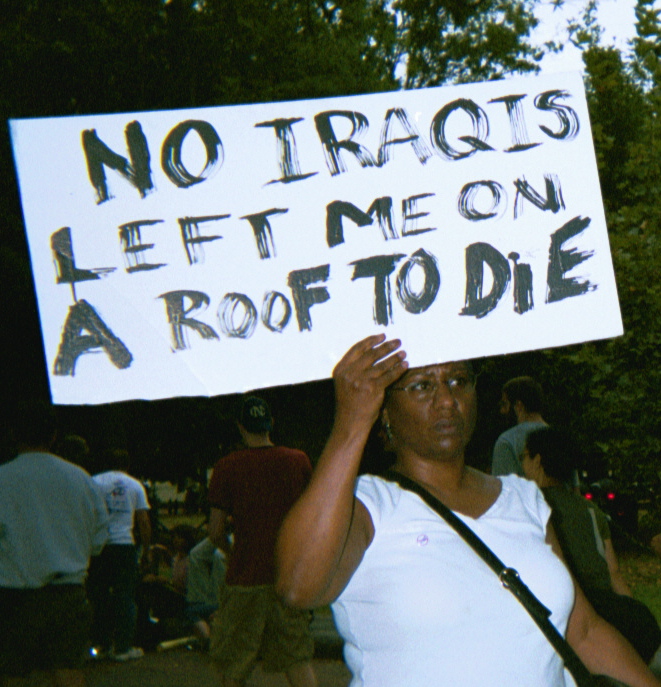In September 2005, hundreds of thousands of people surrounded the White House under the banner “make levees, not war” — connecting the anti-war and climate justice movements in the wake of Hurricane Katrina. Of all the people I saw, one captured the moment best and let me take her photo: an African-American woman holding up a handmade sign saying, “No Iraqis left me on a roof to die” — contemporizing Mohammed Ali’s famous quote against the Vietnam War. While the U.S. government demonizes Arabs and Muslims, and spends billions on war and occupation, the tragedy of Hurricane Katrina showed that the major threat was at home — in the form of poverty, racism, environmental destruction and cut-backs.
Attawapiskat: Canada’s Katrina
This is the Native people’s Katrina moment,” said an Attawapiskat resident in reaction to the current crisis. Both juxtaposed oppression and opulence — from the black community of New Orlean’s 9th Ward who were left to die on rooftops in the shadow of the wealthy French Quarter, to the indigenous community of Attawapiskat who were left to die in tents in the shadow of the richest diamond mine in the Western world. Both were symptomatic of a much broader problem stemming from slavery and colonialism. As NDP Member of Parliament Charlie Angus described in a series of articles that helped highlight the crisis:
“Attawapiskat is the tip of the iceberg for the numerous Bantustan-style homelands of the far north. Years of chronic under funding and bureaucratic indifference has created a Haiti north where dying in slow motion on ice-filled shantytown is considered the norm.”
Both government responses seemed incompetent, but were ideologically driven: first ignoring a tragedy that affected poor and racialized communities, then scapegoating them as criminals (for accessing food or allegedly mismanaging funds), then cramming them into a sports complex, and then trying to forcibly relocate them. Both emergencies became opportunities for disaster capitalism. As Robert Lovelace explained,
“The tragedy at Attawapiskat was not only predictable it was planned. The current government has promoted an ideological solution to the ‘Indian problem’ ever since the Conservative’s incubation as the Reform Party. Their strategy needs a tipping point to convince the Canadian public that it is the only, and more importantly the final, solution. If it not Kashechewan or Attawapiskat, it will be some other community taken to the depth of despair. The plan is to dissolve Reserve communities through offering them up as private property to individual band members and turning Bands into municipalities. One more step away from the legal titles and rights protected under Section 35 of the Canadian Constitution and one more step toward complete economic and social chaos in Indian country.”
Oil, prisons and warfare
To push its austerity agenda the Harper government claims to have no money and demands ordinary people pay for the economic crisis. The accusation that the people of Attawapiskat mismanaged funds is part of this broader narrative, with a specific racist focus on First Nations. The specific accusation of mismanaging $90 million was demolished by this article, and it’s worth putting the $90 million into the broader context of government spending.

While the Harper government claims that $0.09 billion was generous for all the needs of Attawapiskat, it spends $1.4 billion on subsidizing the tar sands — which destroys indigenous lands. It plans on spending $10 billion on prison expansion — and will incarcerate a greater number of indigenous people if its draconian Bill C-10 is passed. And the Harper government plans on wasting billions on oil wars abroad — from $15 billion on fighters jets (the potential real cost of $30 billion is too big to fit on the graph), to $25 billion on naval warships.
Harper justifies the massive military spending on the claim that “the major threat is Islamicism,” and that we need to continue the occupation of Afghanistan into its second decade. But to paraphrase — no Afghans left the people of Attawapiskat in tents to die.
Self-determination
Another justification for militarism is that it can impose democracy, women’s rights or development on communities who supposedly lack the ability to do so on their own. The inherent paternalism in this motive has accompanied Canadian military interventions from Afghanistan, to Haiti, to Libya, and builds on the colonialism on which Canada is based. Because the poverty and oppression that produce humanitarian crises are themselves products of colonialism and imperialism, sending more troops does not solve the problem and instead reinforces the denial of self-determination, whether in Haiti or Haiti north. So if the NDP does convince Harper to send the military to Attawaspiskat, it will become a photo-op to justify military spending and wars abroad, while doing nothing to decolonize at home. Instead we need to support the people of Attawapiskat to meet their own needs, as we collectively challenge the tar sands economy, the war and austerity of the Harper government, and colonialism. As Lovelace explained:
“The antidote for poverty is self-determination and no one can give you that. You have to stand up and take action yourself to make it happen. Colonialism does not give way on its own; it must be defeated through vigorous and enlightened opposition… Only through a convergence of our own self-determination and a willingness of Canada to decolonize can real change take place.”




